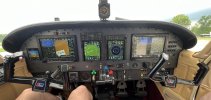@Joe Vedda, The Lycoming publications (which I don't have anymore) recommends EGT operating temperatures to be about 50 degrees rich of peak. Get the aircraft settled in to cruise then lean until peak and slightly enrich it. If you have 6 point EGT lean to the hottest cylinder then about 25*f rich of peak.
The last TIO-540-S1AD I flew the avionics guys put the redline on the digital EGT around 1450*F. It should be closer to 1650*F. Once the aircraft was operating with the actual peak EGT the fuel flow was right on the chart values in the Flight Manual.
Don't know enough about your situation but, the publications for the 100 or so Turbo Saratoga ever built are very rare. Most of the instrument and avionics shops use the non-Turbo publications during setup.


